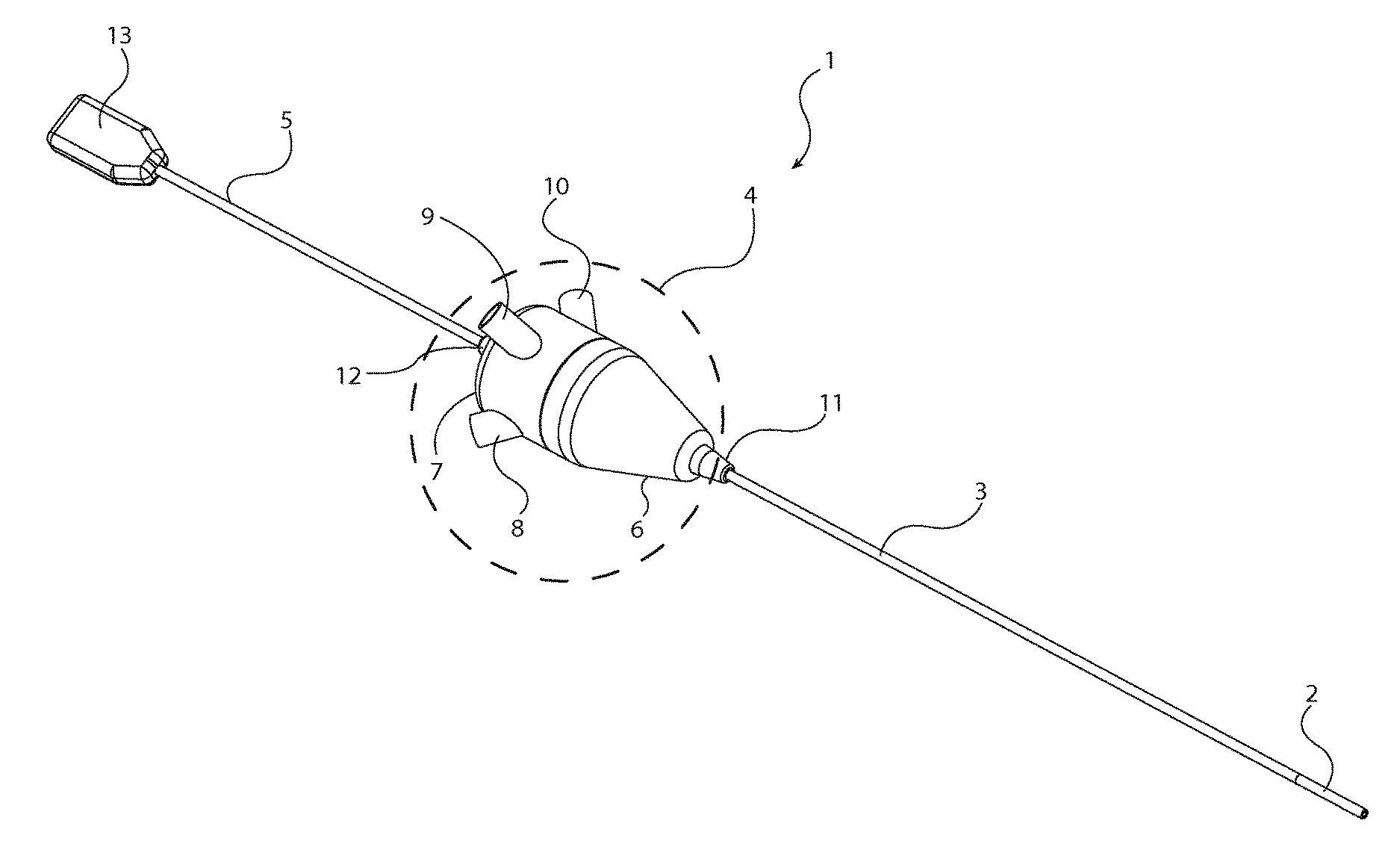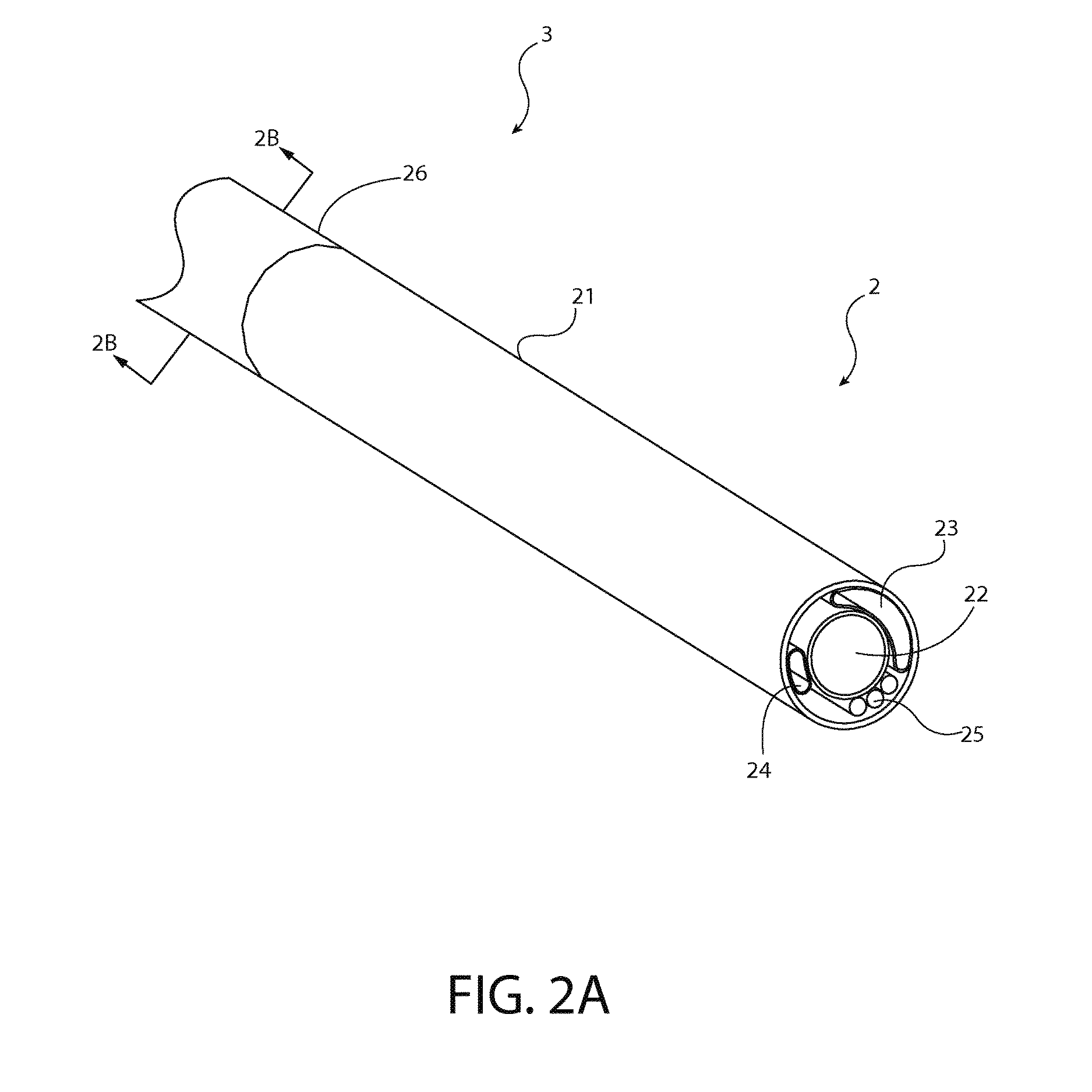Endoscope with Variable Profile Tip
a technology of endoscope and tip, which is applied in the field of single-use electronic endoscope, can solve the problems of limiting post-surgical patient activity, operative or therapeutic arthroscopic surgery has limitations, and takes significant time to heal, so as to facilitate therapeutic endoscope use, avoid delays and costs, and good visualization
- Summary
- Abstract
- Description
- Claims
- Application Information
AI Technical Summary
Benefits of technology
Problems solved by technology
Method used
Image
Examples
example 1
[0102]A 2 mm endoscope with expandable working channel and an LED light source in the hub similar to that shown in FIG. 1 is formed as described below. Two injection-molded ABS pieces 6, 7 (available from Dow Chemical) form the hub enclosure.
[0103]Insert cable assembly 5 with USB connector 13 (available from Molex Connector Corp.) into a strain relief tube 12 and then into a proximal opening in the proximal hub enclosure 7. The strain relief tube 12 is an injection molded component made from Shore A 60 TPE. The cable assembly 5 is electrically connected to a printed circuit assembly (PCA) 61.
[0104]PCA 61 is a small, multi-layer printed circuit board with surface mount integrated circuits to convert USB signals and communications to / from the camera into the signal levels and timing required by the camera specifications. The PCA 61 is affixed to the proximal hub enclosure 7 using four screws 73. See FIG. 7.
[0105]The proximal hub enclosure has an opening for the working channel. A work...
example 2
[0117]An endoscope similar to that described in Example 1 is formed with a variable profile flushing lumen 24 in addition to the variable profile working channel as illustrated in FIG. 2A. A 30 cm length of TPE tubing (Vention Medical PEBAX® tubing catalog number 115-1289; 0.0.279 mm ID, 0.1143 mm wall thickness, 0.51 mm OD, Shore A 63) forms the flushing lumen 24. The process for making the endoscope is similar to Example 1. Differences are discussed below.
[0118]Place the PEBAX® tubing adjacent to the working channel assembly 23 / 28 / 35, and push the proximal end of tubing over a barb fitting the LUER-LOK® lock connector 8. This secures the flushing lumen 24 to the proximal hub enclosure 7. Position the distal end of the flushing lumen tubing 24 adjacent the camera 22 within the expandable tip before sealing the tip.
example 3
[0119]An endoscope similar to that described in Example 2 except the flushing lumen 24 is made from a non-expandable material. Instead of PEBAX® tubing, the flushing lumen 24 is made from polyimide tubing (Vention Medical catalog number 141-0023; 0.508 mm OD, 0.457 mm ID).
[0120]Even though the material itself is non-expandable, the flushing lumen is manufactured to provide that feature. At the distal end, heat press an 8 mm length of the polyimide tubing to form creases and a flattened end. This enables the polyimide tubing to curve around camera 22 inside the expandable outer cover 21. Place a proximal end of the polyimide tubing over the barbed connector of the commercially available connector 8 (a LUER-LOK® component) and affix it with Methyl-Ethyl-Ketone solvent.
[0121]In use, the creased and flattened distal tip of the flushing lumen 24 expands as fluid passes within the flushing lumen 24. This, in turn, expands the outer cover 21. See FIGS. 3 and 4.
PUM
 Login to View More
Login to View More Abstract
Description
Claims
Application Information
 Login to View More
Login to View More - R&D
- Intellectual Property
- Life Sciences
- Materials
- Tech Scout
- Unparalleled Data Quality
- Higher Quality Content
- 60% Fewer Hallucinations
Browse by: Latest US Patents, China's latest patents, Technical Efficacy Thesaurus, Application Domain, Technology Topic, Popular Technical Reports.
© 2025 PatSnap. All rights reserved.Legal|Privacy policy|Modern Slavery Act Transparency Statement|Sitemap|About US| Contact US: help@patsnap.com



